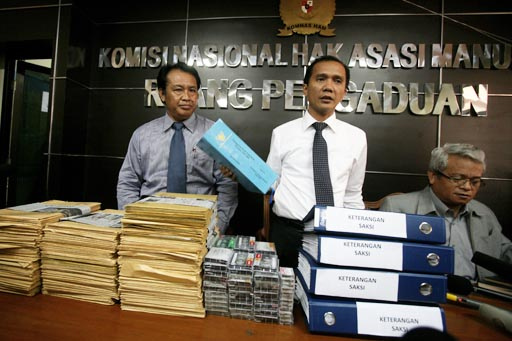A recent Canberra seminar on the infamous mass violence in Indonesia in 1965-66 revealed many parallels with East Timorese experience under Indonesian military occupation a decade later.
CHART’s John Waddingham participated, sharing his Timor archives project experience with those now seeking to build and share documentary evidence on Indonesia’s trauma in the 1960s.
![Indonesian leftists being herded off to public execution. [Source: Unknown]](https://timorarchives.info/wp-content/uploads/2013/02/korban1r.jpg?w=450)
Indonesian leftists being herded off to public execution. [Source: Unknown]
Any critical discussion of the Suharto government’s official narrative on the killings, and its subsequent long-term imprisonment of huge numbers of ‘leftists’, was taboo in Indonesia. The fall of Suharto in 1998 has seen the lid lifted. Indonesian non-government organisations, activists and academics are now openly exploring those events – many with the aim of seeking reparations for victims and their families and holding perpetrators accountable for crimes against humanity.
Seminar topics
Held at the Australian National University, Canberra, New perspectives on the 1965 violence in Indonesia (11-13 February 2013) was organised by Australian-based academics researching 1965. In addition to well-known western researchers in this area like Robert Cribb and Kate McGregor, a number of very active researchers and activists flew in from Indonesia to communicate their work.
Topics included the emerging public debate in Indonesia, the local and Cold War aspects of the killings, Indonesian activist actions to counter the official narrative, to remove stigmas still disadvantaging victims’ families, to collect victim and perpetrator first-hand accounts and to document claims for justice and reparations. Several presentations explored the relationship between Suharto’s military and militias and other non-state actors responsible for many killings. The evidence for external support for the military, especially from the USA and UK, was one of a number of consistent threads in seminar discussion.

Komnas HAM report launch, Jakarta, July 2012. [Jakarta Post]
A recent four year study on 1965 by the official Indonesian National Commission on Human Rights (Komnas HAM) was also discussed. The Commission’s landmark report, completed in July 2012, reported evidence of widespread crimes against humanity including killings, slavery, forced removal and displacement, torture, rape, extra-legal executions. The report recommended State apologies and reparations for victims and that responsible Indonesian military officials be charged with crimes against humanity. The 200-page Indonesian language executive summary is available here.
The Komnas HAM investigations shows that the issue is no longer taboo, but some reactions to the report suggest resistance to truth and justice on the matter remains strong. Indonesia’s Attorney-General, responsible for implementing the recommendations, has rejected the report’s legitimacy.
![Shared experience: Indonesians and East Timorese. [CHART]](https://timorarchives.info/wp-content/uploads/2013/02/chart-slide.jpg?w=450)
Shared experience: Indonesians and East Timorese. [CHART]
CHART participated in the third day of the seminar – a closed session for current activists and researchers to exchange views, information resources and strategies. While time was restricted, John Waddingham outlined CHART’s program and methods to locate, document and provide access to archival materials. He particularly emphasised the importance of authenticating documents to ensure they were genuine and the need to demonstrate the authenticity of newly collected oral and documentary evidence from victims and perpetrators so that they cannot be challenged as fabrications.
Many exact matches were observed in the language to describe the 1965/66 killings and the invasion and occupation of East Timor. This shared experience provides an opportunity for Indonesians and East Timorese to better understand each other’s modern history.
The strong emergence of a raft of Indonesian activists and others now digging into their hidden past is a marvellous development. We hope that one spin-off from this blossoming will be increasing interest from Indonesians in uncovering documentary and other evidence of their military’s interventions in East Timor.
– – – – – – – – – –
Useful introductory guides to the topic:

Thank you for your review of the Conference on “1965 Violence in Indonesia”, and your comments in relation to later disturbing like-events in Timor. Regarding Portuguese Timor in 1965-66 and “Gestapu”, the following extract from “Faltering Steps” – 2010, p.152, might be of some interest:
In mid-1966 however, indicating improved relations, the Portuguese Timor authorities assisted the Indonesians in the repatriation from Dili of two Indonesian communists – who were believed to be enroute to Australia, one described as a “financial backer” of the PKI. The Australian Consul reported that two Indonesian police travelled to Dili from Oecusse in a Transportes Aéreos de Timor (TAT) charter aircraft to recover the two communists. The Consul noted that “the whole operation appears to have been carried out with the full cooperation of the Portuguese authorities. No extradition agreement exists between the two countries. The Indonesian Consul tells me that the Portuguese could not have been more helpful – this is praise indeed, for he generally avoids any opportunity to praise the Portuguese, his natural tendency being to damn them.” (Footnote 1). This, or a similar incident indicating Indonesia-Portuguese Timor cooperation, was related in a 1977 publication:
“In contrast to what happened to the anti-Sukarno Indonesians in 1958 ((ie the granting of asylum to the Permesta 14)), in 1965 Indonesian patriots persecuted by Suharto who sought political asylum in Timor-Leste were delivered back to Suharto. A few years later, an Indonesian aircraft transported Portuguese armed forces personnel from Djakarta to Baucau despite Djakarta’s anti-colonial stance at the United Nations.” (Footnote 2).
Footnote 1: Australian Consul – Dili, Memo 115, 19 June 1966 (NAA: A1838, 3038/2/9). This incident is also related – citing Portuguese documents, in Fernandes, M.S., “O Timor Português na Política Externa de Suharto…, 2006, op.cit., pp.313-314.
Footnote 2. Araújo, A. (Abílio) de, Timor Leste: Os Loricos …, 1977, op.cit., p.183/footnote 204.
Regards, Ernie Chamberlain